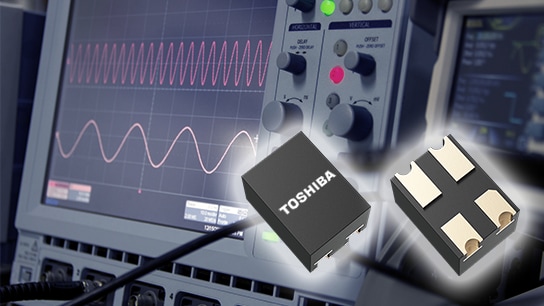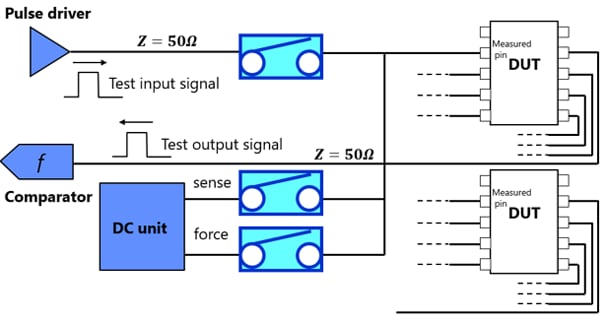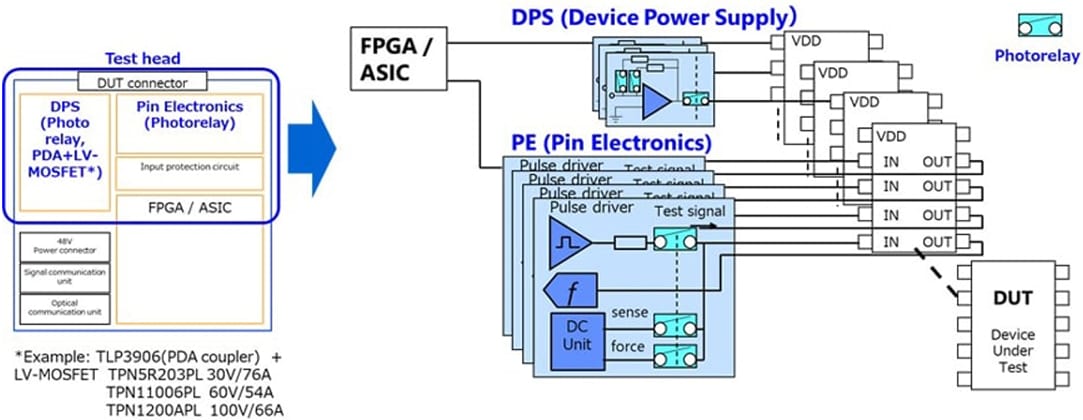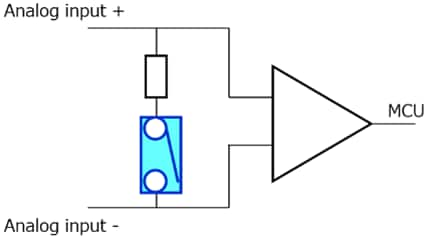- General Top
- SEMICONDUCTOR
- STORAGE
- COMPANY
-
My ToshibaSemicon
- Semiconductor Top
-
ApplicationsAutomotive
Body Electronics
xEV
In-Vehicle Infotainment
Advanced Driver-Assistance Systems (ADAS)
Chassis
IndustrialInfrastructure
BEMS/HEMS
Factory Automation
Commercial Equipment
Consumer/PersonalIoT Equipment
Healthcare
Wearable Device
Mobile
Computer Peripherals
-
ProductsAutomotive Devices
Discrete Semiconductor
Diodes
Transistors
Logic ICs
Analog Devices
Digital Devices
Wireless Devices
※
: Products list (parametric search)
Power SemiconductorsSiC Power Devices
※
: Products list (parametric search)
Isolators/Solid State RelaysPhotocouplers
Digital Isolators
Solid State Relays
Fiber Optic Transmitting Modules
※
: Products list (parametric search)
MOSFETsIGBTs/IEGTsBipolar Transistors※
: Products list (parametric search)
Diodes※
: Products list (parametric search)
MicrocontrollersMotor Driver ICsIntelligent Power ICs※
: Products list (parametric search)
Power Management ICsLinear ICs※
: Products list (parametric search)
General Purpose Logic ICsLinear Image SensorsOther Product ICsOther Product ICs
※
: Products list (parametric search)
-
Design & Development
-
Knowledge
- Where To Buy
- Part Number & Keyword Search
- Cross Reference Search
- Parametric Search
- Stock Check & Purchase
This webpage doesn't work with Internet Explorer. Please use the latest version of Google Chrome, Microsoft Edge, Mozilla Firefox or Safari.
require 3 characters or more. Search for multiple part numbers fromhere.
The information presented in this cross reference is based on TOSHIBA's selection criteria and should be treated as a suggestion only. Please carefully review the latest versions of all relevant information on the TOSHIBA products, including without limitation data sheets and validate all operating parameters of the TOSHIBA products to ensure that the suggested TOSHIBA products are truly compatible with your design and application.Please note that this cross reference is based on TOSHIBA's estimate of compatibility with other manufacturers' products, based on other manufacturers' published data, at the time the data was collected.TOSHIBA is not responsible for any incorrect or incomplete information. Information is subject to change at any time without notice.
require 3 characters or more.
Small photorelay with high-speed switching

Toshiba Electronic Devices & Storage Corporation ("Toshiba") has launched "TLP3450S" a low voltage photorelay for semiconductor testers.
Semiconductor testers (ATE: Automated Test Equipment) verify that DUT is operating correctly by applying a voltage/current to the specified pins of the device under test (DUT), such as the system LSI or semiconductor memory. A number of photorelays (MOSFET output), a type of solid state relay, are used to switch the route of the specified pins.
ATE is required to be throughput-efficient in order to measure a lot of DUT with a large number of pins at once. Thus, high-speed switching is required to reduce the loss of test time due to switching. Also to meet this demand, photorelays are required to be miniaturized in order to mount a large number on a limited board space.
In addition, because of its small size and high temperature operation, it is a semiconductor switch that can be used in a wide range of applications, including PLC (Programmable Logic Controller) and other industrial equipment, in addition to ATE applications.
The new TLP3450S uses a small S-VSON4T package. We have also improved the optical output of infrared LEDs and optimizing the design of photo detector devices (photodiode arrays). As a result, the switching time (turn-on time) of the new product is 80μs (max), which is 40% of the existing product TLP3450. In addition, TLP3450S has a smaller output capacitance that affects high-frequency signal leakage when the output is turned off, and a lower on-resistance that affects signal attenuation when the output is turned on. TLP3450S is suitable for the pin electronics of semiconductor testers, which measure DUT with high accuracy and at high speeds.

Product Features
- Fast turn-on time
- Small output capacitance
- Small package S-VSON4T for high-density mounting
1. Fast turn-on time

In ATE, many DUT with many terminals must be measured in limited time. If the switching time of the photorelay itself is slow, DUT testing time will be longer. This product has a turn-on time of 80μs (max), which is 40% of our existing product TLP3450. This contributes to the overall throughput of the system.
2. Small output capacitance

Capacitance between the MOSFET’s output pins in the off state is called output capacitance and is expressed as COFF. When a signal other than direct current such as pulse is controlled, the signal leaks through this capacitance when the photorelay is off state. Especially in ATE, highly accurate DUT measurement is required, but it is not preferable if COFF is large, because the leakage current easily flows. Although COFF of our existing product TLP3450 is 0.8pF (typ.), this product achieves 0.6pF (typ.) Signal leakage in off state can be further suppressed.
3. Small package S-VSON4T for high-density mounting

The test head has two major categories: the device power supply (DPS) and the pin electronics (PE). ATE uses relays to switch power supply and signal to measure a number of DUTs at once. While technological innovations such as high-speed processing of testers are unusual, high density test boards are inevitable for semiconductor testers that must cope with low cost and high reliability. Existing mechanical relays cannot meet these requirements, and semiconductor relays (photorelays) replace them, so many photorelays are mounted in a limited board space. The new TLP3450S uses a small package S-VSON4T (1.45mm×2.0mm (typ.), t=1.4mm (max)) that can contribute to improved mounting density. The footprint is approximately 18% smaller than that of our existing product TLP3450.
Applied equipment

- Semiconductor testers (high-speed memory testers, high-speed logic testers, etc.)
- Probe card
- Various measuring instruments
- Industrial equipment
* It is also suitable for applications such as PLC (Programmable Logic Controller) which have a number of interfaces on a small frame.
Main specifications of the new product
(Ta=25°C)
Related information
Product information
Technical Article
Application
Package
Queries about purchasing, sampling and IC reliability
Stock Check & Purchase
require 3 characters or more.
* Company names, product names, and service names may be trademarks of their respective companies.
* Information in this document, including product prices and specifications, content of services and contact information, is current on the date of the announcement but is subject to change without prior notice.
